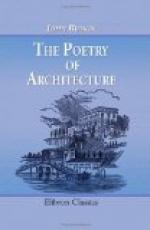76. Figs. q, r, s are Swiss. Fig. r is one specimen of an extensive class of decorated chimneys, met with in the northeastern cantons. It is never large, and consequently having no false elevation of character, and being always seen with eyes which have been prepared for it, by resting on the details of the Swiss cottage, is less disagreeable than might be imagined, but ought never to be imitated. The pyramidal form is generally preserved, but the design is the same in no two examples.
Fig. s is a chimney very common in the eastern cantons, the principle of which we never understood. The oblique part moves on a hinge, so as to be capable of covering the chimney like a hat; and the whole is covered with wooden scales, like those of a fish. This chimney sometimes comes in very well among the confused rafters of the mountain cottage, though it is rather too remarkable to be in good taste.
77. It seems then, that out of the eighteen chimneys, which we have noticed, though several possess character, and one or two elegance, only two are to be found fit for imitation; and, of these, one is exclusively a cottage chimney. This is somewhat remarkable and may serve as a proof:—
First, of what we at first asserted, that chimneys which in any way attract notice (and if these had not, we should not have sketched them) were seldom to be imitated; that there are few buildings which require them to be singular, and none which can tolerate them if decorated; and that the architect should always remember that the size and height being by necessity fixed, the form which draws least attention is the best.
78. Secondly, that this inconspicuousness is to be obtained, not by adhering to any model of simplicity, but by taking especial care that the lines of the chimney are no interruption, and its color no contrast, to those of the building to which it belongs. Thus Figs. h to m would be far more actually remarkable in their natural situation, if they were more simple in their form; for they would interrupt the character of the rich architecture by which they are surrounded. Fig. d, rising as it does above an old Gothic window, would have attracted instant attention, had it not been for the occurrence of the same lines in it which prevail beneath it. The form of n only assimilates it more closely with the roof on which it stands. But we must not imitate chimneys of this kind, for their excellence consists only in their agreement with other details, separated from which they would be objectionable; we can only follow the principle of the design, which appears, from all that we have advanced, to be this: we require, in a good chimney, the character of the building to which it belongs divested of all its elevation, and its prevailing lines, deprived of all their ornament.




